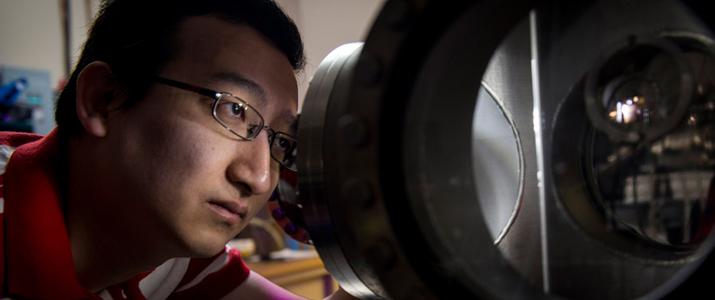

Facilities Used by Physics & Astronomy Faculty & Students
- Ohio University Observatory
- Edwards Accelerator Lab
- Helium Recovery and Liquefaction Facility
- Kitt Peak and MDM Observatory
- Laser Tweezers Lab
- Laboratory for Single Atom and Molecule Manipulation
- Low Temperature SP-STM Laboratory
- Nanoscale and Quantum Phenomena Institute
- Nanophotonics & Spectroscopy Group
- Physics Machine Shop
- Room Temperature MBE/STM Laboratory
Ohio University Observatory
The Ohio University Observatory is sited at The Ridges on the hilltop between Konneker Research Laboratory and the water tower. Astrophysical Institute faculty members sponsor programming at the observatory.
Edwards Accelerator Lab
The John E. Edwards Accelerator Laboratory provides ion beams and the associated detection equipment for the study of nuclear reactions of interest for nuclear structure, nuclear astrophysics, materials science, inertial confinement fusion, nuclear energy, homeland security, and other applications. This research is performed by Ohio University students, faculty, and staff, as well users from other universities and laboratories. A complete roster of students, faculty, and staff working in the area of nuclear physics, and descriptions of their research, may be found on the Institute of Nuclear and Particle Physics website .
Helium Recovery and Liquefaction Facility (Clippinger Research Annex)
The Helium Recovery and Liquefaction Facility recycles boiled-off helium gas from the research laboratories. The gas is returned to the facility by means of leak-tight return pipelines. The gas is temporarily stored in high pressure cylinders and then goes through a series of compression and liquefaction stages to ultimately return to a liquid state at 4.2 K. The liquefied helium is then stored in a 1,000-liter storage tank until being re-distributed back to the research labs via 100 L dewars. This facility achieves 95 percent gas recovery efficiency, conserving Earth's precious helium resource, and providing a readily available source of liquid helium for the department's low-temperature research.
Kitt Peak and MDM Observatory
Ohio University is a member of the MDM Consortium, which owns and operates the 1.3 meter and 2.4 meter telescopes at the MDM Observatory on Kitt Peak in Southern Arizona, 50 miles west of Tucson. Other members of the consortium are the University of Michigan, Dartmouth College, Ohio State University, and Columbia University.
Laser Tweezers Lab
Laser tweezers (aka optical tweezers or optical trapping) uses a tightly focused infrared laser beam to trap and move microscopic particles suspended in a fluid. This is a useful way to pick up and hold onto tiny objects that would be difficult to manipulate any other way. The Laser Tweezers Lab in the Physics & Astronomy Department at Ohio University has an optical tweezers setup with the ability to create multiple independently movable traps using a computer-controlled spatial light modulator. Contact Dr. David Tees to find out more about using the Laser Tweezers or to schedule a demonstration.
Laboratory for Single Atom and Molecule Manipulation
The Laboratory for Single Atom and Molecule Manipulation is located next to Clippinger Laboratories and the Edward Accelerator Laboratory, where the Surface Science Laboratory serves as its own natural vibration isolation environment. Both LT-STM systems are custom-built and are capable of all the atom/molecule manipulations and tunneling spectroscopy measurements including vibrational spectroscopy and mapping.
Low Temperature SP-STM Laboratory
The Low Temperature SP-STM Laboratory applies both normal and spin-polarized scanning tunneling microscopy at liquid helium temperatures and with the addition of applied magnetic fields up to 4.5 Tesla to investigate complex materials systems grown by either molecular beam or pulsed laser epitaxy. Freshly prepared samples are transferred through ultra-high vacuum through a central distribution chamber and then into the STM chamber. Researchers are interested in the atomic-scale structural, electronic, and spin magnetic properties of surfaces and manipulation of those properties. Materials of interest include nitride semiconductors, magnetic nitrides, magnetic bi-layer systems, and magnetic nitride semiconductors. For more information, see Dr. Arthur Smith's research website .
Nanoscale and Quantum Phenomena Institute
The Nanoscale and Quantum Phenomena Institute includes a group of 25 faculty members from seven different departments and two colleges focusing on carrying out interdisciplinary research in nanoscience. The three main missions of the institute are: to promote research excellence in nanoscale science and engineering, to foster cross-disciplinary research and education in nanoscience, and to realize international collaborations, conferences, and workshops.
The three main areas of research are: 1) nanoelectronics, nanophotonics, nanospintronics, and nanomagnetism; 2) nanoscale properties, manipulation, and assembly; and 3) quantum structures, nanocrystals, and nanosensors. The institute also fosters the development of advanced research instrumentation and key facilities to support the research. In addition, NQPI hosts international visitors and students, supports special colloquia and seminars, publishes a bi-annual newsletter, and reaches out to Southeastern Ohio schools and the general public.
Nanophotonics & Spectroscopy Group
The Nanophotonics & Spectroscopy Group investigates the optical and electronic properties of novel semiconductor nanostructures and nanostructure based devices. The lab utilizes optical techniques to study the properties such as spin coherence and control, quantum mechanical tunneling, entanglement, photon-nanostructure interactions, charging behavior, interactions with the environment, and device characteristics. Dr. Eric Stinaff is the principal investigator.
Physics Machine Shop
The Physics Machine Shop is equipped with high-precision machine tools for virtually any machining, fabrication, or assembly projects. Professional high-quality toolmakers specialize in manufacturing experimental research apparatuses.
Room Temperature MBE/STM Laboratory
The Room Temperature MBE/STM Laboratory studies nitride and magnetic material systems grown by molecular beam epitaxy and transferred directly into the STM chamber under UHV conditions. Samples are investigated using STM at room temperature. Researchers are interested in topographical, structural, electronic, and magnetic properties of the surfaces down to the atomic scale. Both normal and spin-polarized STM (using magnetic coated tips) are employed to obtain this information. For more information, see Dr. Arthur Smith's research website .
